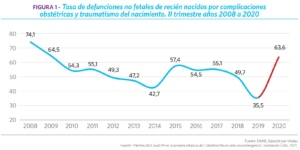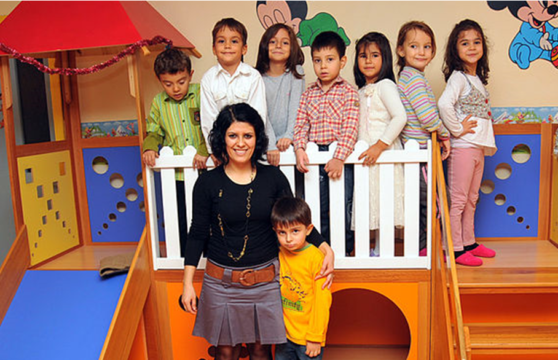High-quality Early Childcare = Later Academic Success?
Two documents suggest that investing in the early years of poor children is crucial to long-term success.
This post is also available in: Spanish
How has the pandemic affected the growth of children in the Latin American region? In Colombia, the organization NiñezYA seeks to understand how the pandemic has affected children and jeopardized their rights. We had the opportunity to talk to Ángela Constanza Jerez Trujillo, coordinator of NiñezYA, about their new report and its implications for both Colombia and Latin America.
The report highlights that the pandemic will leave its imprint on all of us, but especially on children and teenagers. While medically this population is not considered a high-risk group, the impact is noticeable in a significant uptick in maternal deaths, lack of healthcare for children and teenagers, increased food insecurity, decreased access to healthy food, and reduction in food portions. The World Bank estimates that between 88 and 115 million people were left in extreme poverty in 2020. What are the expected consequences of this situation?
In NiñezYA, we have analyzed the particular situation of Colombia in relation to these issues and the results are very concerning. In particular, maternal deaths have a devastating effect on infants. Studies show that the likelihood of survival in children whose mothers died during the first 42 days after childbirth is much lower compared to children of surviving mothers. In addition, maternal deaths prevent easy access to milk and maternal care, which are key in early development. In 2019, 261 early maternal deaths were filed in Colombia, while in 2020 there were 348. Although this cannot be solely attributed to the pandemic, the current situation suggests that hospital services are prioritizing Covid-19 care, limiting fronts such as child and maternal care.

As for the lack of monitoring of the health and development of children, the consequences are immeasurable at this time, as there is no knowledge of what happened to children who did not attend their check-ups, especially during the first year of life and gestation, when humans go through the greatest developmental changes. Having timely information on the difficulties that children may have growing up makes an important difference in taking appropriate action.
As for food insecurity, which is directly related to lack of income for families, research shows that it is affecting the most vulnerable populations, as well as new populations who were not previously affected by the issue. Prior to the pandemic and its restrictions, a total of 89.3 percent of Colombia’s households consumed three meals a day. Now, that figure has dropped to 69.3percent, according to the National Administrative Department of Statistics’ (DANE) Social Pulse survey of December 2020. In certain regions of the country, that percentage is even lower. This is the case in the Caribbean region, where there are cities like Santa Marta, where it went from 99.5 percent to 40.1 percent; or Cartagena which was at 70.3 percent and is now at 34.1 percent (See chart in the report here).
This situation will result in an increase in obesity, chronic and acute malnutrition rates, conditions that increase the risk of chronic nontransmissible diseases, and will cause lags for the rest of a child’s life if it occurs during early childhood. Chronic malnutrition affects physical and cognitive development and acute malnutrition can lead to death. Fundación Success estimates that Colombia will be set back four years in its goal of having zero cases of chronic malnutrition in children under 5 years of age by 2034, which is now at 10.8 percent on average.
What actions should countries in the region take to remedy this situation?
At NiñezYA, we advocate for the following (see the full list here):
We have observed that during the pandemic the physical and emotional health of children and teenagers has suffered greatly. This study highlights that “the effects on the socio-emotional state of children, as well as caregivers, is another relevant problem,” which is evident in surveys that mention symptoms of increased anxiety and worry. What long-term effects can be expected of this situation? How should this problem be addressed and which sectors and actors should play a relevant role in addressing this issue?
Different surveys and evaluations show socio-emotional problems in children, teenagers, and their parents and caregivers. Lack of social interaction, limited demonstrations of affection, and living in a context of fear can affect emotional intelligence and the development of nonverbal cognitive, social, and communicative skills in children, especially the youngest.
The emotional impact on adults also affects children and teenagers. The presence of toxic levels of stress during pregnancy can affect the development of the brain structures of the fetus in the womb. Additionally, the high levels of stress adults experience can seriously interfere with care and parenting skills.
We believe that the best way to address this issue is by returning to development centers for children and schools, with all biosecurity measures. This should be coupled with accompanying and training caregivers and teachers so that they can support children and teenagers in this new process that is unfamiliar to all of us. In this sense, the participation of the education sector, the health sector, parents’ associations, experts in education and mental health and civil society, among others, is required. It is important to listen to children and teenagers on how to address this problem and take their opinions into account.
Scientific evidence sustains the relevance of preschool education. An Inter-American Development Bank (IDB) (2020) simulation estimates significant losses in gross domestic product (GDP) if children stop attending preschool. During the pandemic, countries have invested in educational technology to support remote education, however, many students do not yet have access to devices or a stable internet connection. This has widened learning gaps and inequity in education. Considering what we learned during the pandemic regarding the use and access to Information and Communications Technology (ICT) and the relationship between in-person and virtual assistance, what measures should be strengthened to ensure universal access to quality education in Colombia and other countries in the region?
In the case of Colombia, similarly to the rest of the region, internet access and devices are not the same for children and teenagers. This depends on their socioeconomic sphere and geographical location (rural or urban). For example, in Bogota (the capital), 8 out of 10 private school students have access to high-speed internet, while 5 out of 10 students from official colleges have access to high-speed internet access (National Consulting Center, Uniandes and ProBogotá). In addition, the capacities of the adults who accompany and supervise them are not the same and that also impacts education.
NiñezYA supports the recommendations that education experts have pointed out, several of whom are in our coalition. These include (see full list here):
It is important to keep in mind the following recommendations to care for the population with disabilities, which is now more marginalized than before the pandemic, according to information from Economic Commission for Latin America and the Caribbean (ECLAC).
In Colombia, the study highlights that there is concern in the community about dropouts. What recommendations can be made to governments and schools to combat dropouts in 2021 and after the pandemic?
It is important to note that the 7.6 percent dropout rate is specific to Bogota, the capital city, and could now be up to three times what was reported in 2020. There is no information at the national level.
NiñezYA is supporting the return of children and teenagers to schools, with all biosecurity measures, with the campaign called PresentesYA. At this time, March 31, 2021, only 11.6 percent of students from educational institutions in the official sector have returned to school (according to figures from Fundación Empresarios por la Educación, a member of NiñezYA). In order for them to return, on the one hand, local authorities are required to utilize the central resources allocated in the proportion educational institutions need. As of the above date, only 22.7 percent of these resources have been implemented. On the other hand, it is urgent that the central government completes the work that had begun to update the school infrastructure that had large lags (buildings from 60 years ago that did not have basic services such as water, sewage, light, and sanitary batteries). Similarly, the government must design strategies that combat the reasons for the dropouts, which have to do with school (learning) and family (income, among others) problems.
Fundación Empresarios por la Educación, a member of NiñezYA, conducted a survey of the country’s education secretaries, representing 64.4 percent of school enrollment. They noted several important elements to consider when developing strategies to combat dropouts, including:
Domestic violence has been a major challenge during the pandemic in the region. In the report, a key recommendation to mitigate domestic violence and other situations that jeopardize the well-being of children is to strengthen the “peaceful interpersonal, family and community relationships, based on respect, reciprocity and communication” with the understanding that “children and teenagers need new paradigms based on loving parenting and building equitable gender roles.” Have there been successful programs that promote healthy communication at home?
At the stroke of midnight on March 23, the Colombian Congress passed a law against physical punishment, that forbids parents and caregivers from the use of any form of mistreatment to educate children and teenagers. The law also has a pedagogical, persuasive and alternative objective, through the promotion of loving, violence-free parenting practices, respectful of the fundamental rights of children in Colombia. To this end, the project encourages the creation of a national pedagogical strategy, through which parents can access counseling and psychological support to acquire tools that will help them raise their children and correct them without violence. Government entities related to this issue, civil society, parents, and coalitions such as NiñezYA are expected to participate in this strategy.
A final reflection: the importance of healthy play and conversations are a crucial aspect of the development of children. How can countries in the region regain playful and healthy spaces after the pandemic? Who can lead these efforts?
Longitudinal research conducted by the National University of Colombia on children who attended and did not attend play libraries (known in Spanish as Ludotecas, which are public spaces with toys designed to encourage play) showed that the former were able to develop skills for coexistence, such as the ability to listen, negotiate, put themselves in each other’s shoes, and be creative. It is important that national and local governments provide exclusive spaces for children to play with each other and have encounters with adults. This promotes healthy family coexistence and peer empathy. NiñezYA suggests:
All these efforts must be led by local authorities and include the entire community and input from children and teenagers.
The pandemic jeopartized the rights of children – NiñezYa Report.
Two documents suggest that investing in the early years of poor children is crucial to long-term success.
An op-ed piece on the importance of developing “soft skills” in school.
Promoting economic growth by investing in human capital through education.

